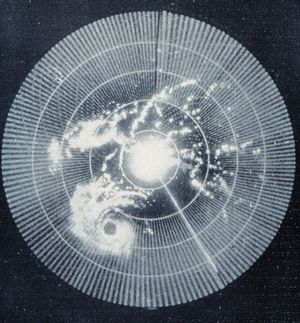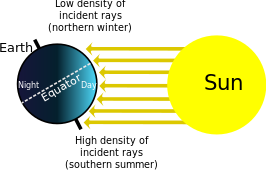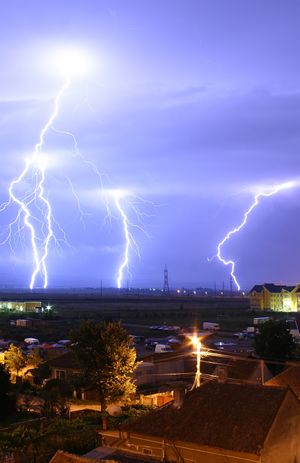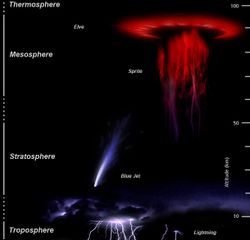فيزياء الغلاف الجوي
| علوم الغلاف الجوي [تص.] |
|---|
| علم الأرصاد الجوية [تص.] |
| علم المناخ [تص.] |
|
|
فيزياء الغلاف الجوي Atmospheric physics هي تطبيق الفيزياء على دراسة الغلاف الجوي. فيزيائيو الغلاف الجوي يحاولون نمذجة غلاف الأرض الجوي والأغلفة الجوية لباقي الكواكب باستخدام معادلات جريان الموائع، نماذج كيميائية، توازنات الإشعاع، عمليات انتقال الطاقة في الغلاف الجوي. لكي تتم نمذجة أنظمة الطقس، يستخدم الفيزيائيون عناصر من نظرية التبعثر scattering theory، نماذج تقدم الموجة، فيزياء الغيوم، ميكانيكا إحصائية وإحصاء حيزي spatial statistics وهي مواضيع رياضية متقدمة ومرتبطة بالفيزياء. ترتبط فيزياء الغلاف الجوي بشكل كبير بعلم المناخ و meteorology ويغطي أيضا تصميم وتركيب الآلات لدراسة الغلاف الجوي و تفسيرات البيانات، بما فيها أدوات الاستشعار البعادي (الاستشعار عن بعد) remote sensing.
الاستشعار عن بعد
| جزء من سلسلة الطبيعة عن |
| الطقس |
|---|
 |
|
|

الإشعاع

Atmospheric physicists typically divide radiation into solar radiation (emitted by the sun) and terrestrial radiation (emitted by Earth's surface and atmosphere).
فيزياء السحاب
Cloud physics is the study of the physical processes that lead to the formation, growth and precipitation of clouds. Clouds are composed of microscopic droplets of water (warm clouds), tiny crystals of ice, or both (mixed phase clouds). Under suitable conditions, the droplets combine to form precipitation, where they may fall to the earth.[1] The precise mechanics of how a cloud forms and grows is not completely understood, but scientists have developed theories explaining the structure of clouds by studying the microphysics of individual droplets. Advances in radar and satellite technology have also allowed the precise study of clouds on a large scale.
كهرباء الغلاف الجوي

Atmospheric electricity is the term given to the electrostatics and electrodynamics of the atmosphere (or, more broadly, the atmosphere of any planet). The Earth's surface, the ionosphere, and the atmosphere is known as the global atmospheric electrical circuit.[2] Lightning discharges 30,000 amperes, at up to 100 million volts, and emits light, radio waves, X-rays and even gamma rays.[3] Plasma temperatures in lightning can approach 28,000 kelvins and electron densities may exceed 1024/m³.[4]
علم الأجواء العليا
Aeronomy is the science of the upper region of the atmosphere, where dissociation and ionization are important. The term aeronomy was introduced by Sydney Chapman in 1960.[5] Today, the term also includes the science of the corresponding regions of the atmospheres of other planets. Research in aeronomy requires access to balloons, satellites, and sounding rockets which provide valuable data about this region of the atmosphere. Atmospheric tides play an important role in interacting with both the lower and upper atmosphere. Amongst the phenomena studied are upper-atmospheric lightning discharges, such as luminous events called red sprites, sprite halos, blue jets, and elves.
انظر أيضا
|
|
مراجع
- ^ Oklahoma Weather Modification Demonstration Program. CLOUD PHYSICS. Archived 2008-07-23 at the Wayback Machine Retrieved on 2008-04-15.
- ^ Dr. Hugh J. Christian and Melanie A. McCook. Lightning Detection From Space: A Lightning Primer. Archived أبريل 30, 2008 at the Wayback Machine Retrieved on 2008-04-17.
- ^ NASA. Flashes in the Sky: Earth's Gamma-Ray Bursts Triggered by Lightning. Retrieved on 2007-06-01.
- ^ Fusion Energy Education.Lightning! Sound and Fury. Archived 2016-11-23 at the Wayback Machine Retrieved on 2008-04-17.
- ^ Andrew F. Nagy, p. 1-2 in Comparative Aeronomy, ed. by Andrew F. Nagy et al. (Springer 2008, ISBN 978-0-387-87824-9)

